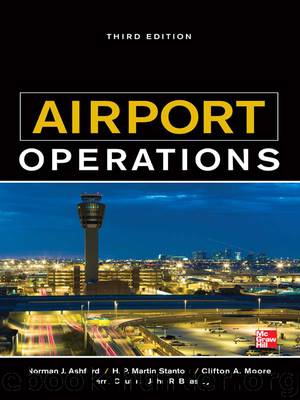Airport Operations by Norman Ashford

Author:Norman Ashford
Language: eng
Format: epub
Tags: -
Publisher: McGraw-Hill Education
Published: 2012-09-30T16:00:00+00:00
FIGURE 11.4 Planned FAB configuration for Europe. (Source: Eurocontrol.)
A major benefit that should accrue from ATM developments is the implementation of “free flight” services. The ultimate goal is to offer aircraft a straight track from departure point to destination. This will be compromised still by terminal-area procedures at airports, which must respect the runway direction(s) in use. In some countries there is already considerable progress with continuous-decent-approach (CDA) operations allowing considerable descent and landing-fuel savings. Also reduced vertical separation minima (RVSM) are being introduced in areas of the upper airspace, and by reducing the once-obligatory 2,000-foot separation minimum between opposing directions traffic above FL290 (flight level equivalent to 29,000 feet) to 1,000 feet, there is consistent vertical separation throughout controlled airspace and an approximate 100 percent of additional cruise-level capacity. This benefit has arisen largely from the improvement in onboard sensing of vertical position on modern aircraft and is not directly attributable to ground systems improvements.
Emerging from research into implementation in recent years has been an ATM-originated concept called collaborative decision making (CDM). Airports can be affected by operational circumstances that affect capacity, for example:
Download
This site does not store any files on its server. We only index and link to content provided by other sites. Please contact the content providers to delete copyright contents if any and email us, we'll remove relevant links or contents immediately.
Whiskies Galore by Ian Buxton(40603)
Introduction to Aircraft Design (Cambridge Aerospace Series) by John P. Fielding(32359)
Small Unmanned Fixed-wing Aircraft Design by Andrew J. Keane Andras Sobester James P. Scanlan & András Sóbester & James P. Scanlan(32154)
Craft Beer for the Homebrewer by Michael Agnew(17467)
Turbulence by E. J. Noyes(7068)
The Complete Stick Figure Physics Tutorials by Allen Sarah(6654)
Kaplan MCAT General Chemistry Review by Kaplan(6078)
The Thirst by Nesbo Jo(5810)
Bad Blood by John Carreyrou(5794)
Learning SQL by Alan Beaulieu(5440)
Weapons of Math Destruction by Cathy O'Neil(5064)
Man-made Catastrophes and Risk Information Concealment by Dmitry Chernov & Didier Sornette(4764)
iGen by Jean M. Twenge(4712)
Digital Minimalism by Cal Newport;(4595)
Life 3.0: Being Human in the Age of Artificial Intelligence by Tegmark Max(4530)
Audition by Ryu Murakami(4117)
Electronic Devices & Circuits by Jacob Millman & Christos C. Halkias(4058)
1,001 ASVAB Practice Questions For Dummies by Powers Rod(4054)
Pale Blue Dot by Carl Sagan(4027)
